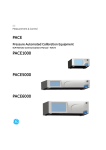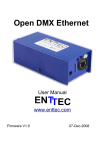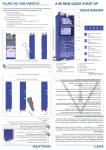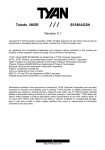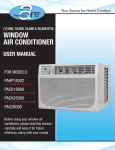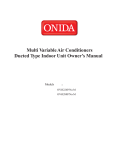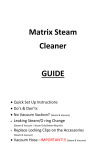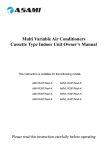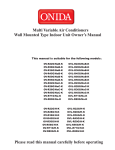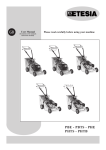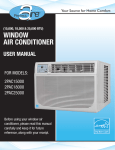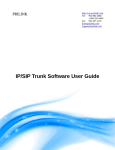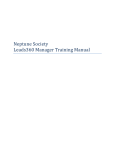Download Wing User Manual
Transcript
ENTTEC Wing (This manual suits all wing types) User Manual www.enttec.com Firmware V1.2 25-May-2008 This page Blank ENTTEC Wing User Manual 2 Table of Contents This page Blank..........................................................................................2 Contents........................................................................................................4 Contacting ENTTEC.....................................................................................4 Warranty.......................................................................................................5 Introduction...................................................................................................6 Features.........................................................................................................6 Shortcut Wing..........................................................................................6 Playback Wing.........................................................................................7 Programming Wing..................................................................................7 Getting Started ............................................................................................7 Ethernet Connection.................................................................................7 Using the wing with LightFactory................................................................8 Connecting the wing................................................................................8 ..................................................................................................................9 Mapping the wing in LightFactory.........................................................10 The Programming Wing and LightFactory............................................11 Configuring the wing..................................................................................26 NMU-based Configuration.........................................................................26 Art-Net Mode .............................................................................................26 Updating the firmware...........................................................................30 Appendix 1..................................................................................................34 Appendix 2..................................................................................................36 ENTTEC Wing User Manual 3 Contents When you open the packaging, you should find these items in the box: • • • • • • • ENTTEC Wing User Manual 9V Power supply (pn: 79104) Cross over cable (pn:79101) Straight cable (pn:79102) IP address Label CD If one of these items is missing please contact your local dealer. The user manual for all ENTTEC Wings is the same. Please refer to the section relating to that specific product. Contacting ENTTEC To contact us, please send an email to: [email protected] Tel: +61 3 9763 5755 GMT+10 Fax: +61 3 9763 5688 To write us: ENTTEC Pty Ltd Unit 17/5 Samantha Court Knoxfield, VIC 3180 AUSTRALIA ENTTEC Wing User Manual 4 Warranty ENTTEC warrants that the product it manufactures and sells will be free from defects in materials and workmanship for a period of 1 year from the date of shipment from an authorized ENTTEC wholesaler. If the device proves defective within the respective period, ENTTEC will repair or replace the defective hardware at its sole discretion. If the failure is due to an operator error the user accepts to pay for any charge relating to the diagnosis of the hardware, faulty parts or shipping from our factory. ENTTEC makes no warranty of any kind, express or implied, including without limitation the implied warranties of merchantability and fitness for a particular purpose. In no event shall ENTTEC be liable for indirect, special or consequential damages. Opening the unit voids the warranty as described above. ENTTEC Wing User Manual 5 Introduction Thank you for buying the ENTTEC Wing. At ENTTEC we are proud of our products and we hope you will enjoy them as much as we enjoy making them. This manual was written primarily to describe operation of the ENTTEC Wing with ENTTEC LightFactory software. This is referred to as the ENTTEC MODE of operation. There is another mode of operation, called the Art-Net mode, which is covered in a separate section. Finally, other programs are planning to support the wings, and their operation as it relates to those software titles will be explained in full by those vendors. Firstly, un-pack the unit from the box. On the rear panel, you will find : • RJ45 Ethercon connector for a 10Base-T Ethernet connection • Status Led indicating if the device is powered up and running • Activity Led indicating the presence of packets on the network • Link led indicating the presence of an Ethernet connection • 9V AC or DC power connector The unit has no power switch and can be left on continuously. Features Shortcut Wing • • • • • Ethernet Interface 60 High quality Cherry MX Keys 2 Digit 7 Segment LED display PAGE UP & PAGE DOWN Keys Upgradeable firmware ENTTEC Wing User Manual 6 Playback Wing • • • • • • • Ethernet Interface 40 High quality Cherry MX Keys 10 High Quality 60mm Faders 2 Digit 7 Segment LED display PAGE UP & PAGE DOWN Keys Large GO & BACK Keys Upgradeable firmware Programming Wing • • • • • Ethernet Interface 62 High quality Cherry MX Keys • PAGE UP & PAGE DOWN Keys for Encoder • 9 Window Keys • 25 Operational & Function Keys • 19 Key Numeric Keypad • 4 Arrow Keys and Backspace 3 Rotary Encoders 4 line 20 character LCD Display Upgradeable firmware Getting Started Ethernet Connection Firstly, you need to connect your wing and the computer running LightFactory. If you have an available Ethernet port on your computer, you can connect your Wing directly to your computer using a cross-over patch lead. If your Ethernet port is already in use, or you are using more than one Wing, you will need to connect the computer and the Wing/s to an Ethernet Hub or Switch using a standard Ethernet patch cable. Do not use power over Ethernet hubs or switches. Once you’ve connected the Wing and the computer the Link LED should ENTTEC Wing User Manual 7 light up immediately. If not, check the Ethernet cable you’ve used is the correct type (ie – cross over or straight through) and is in good working order, and the computer and hub/switch are functioning correctly. You may see the Activity LED blinking occasionally if there is activity on the Ethernet network. Using the wing with LightFactory Connecting the wing Make sure the wing is connected correctly and powered up. Start Light factory and go to the File->System Properties->External Wings This screen will display the connected wings. In the event you see a warning on the screen, this is due to the fact the IP ranges of your computer and the wing do not match. This means for ENTTEC Wing User Manual 8 example that the wing would have an IP of 10.7.81.161 and your computer 192.168.0.23. In this case both devices are not on the same subnet and cannot talk to each other properly. You can either change the IP of the wing to be in the same subnet as the computer (see “Configuring the Wing” on page 11 for details), or change the IP of the computer to be in the same subnet as the wing. For example if the wing has an IP of 10.7.81.161 , you would set the computer to ip 10.7.81.1 with a net mask of 255.255.255.0 You can check your computer’s IP address by clicking on 'Start' then 'Run', type cmd (enter). This will open a command window, then type: ipconfig and press enter This will display the IP address of your computer. ENTTEC Wing User Manual 9 Mapping the wing in LightFactory The wing is automatically configured by LightFactory: – – – Playback wing: – Page 0, Fader 1 on the wing is linked to Submaster 1 and Playback 1 in LightFactory. – Page 1, Fader 1 corresponds to Submaster 101 and Playback 11. – Page 2, Fader 1 corresponds to Submaster 201 and Playback 21. – etc. Shortcut Wing: – Page 0, Button 1 is linked to Shortcut 1 in LightFactory. – Page 1, Button 1 corresponds to Shortcut 101 – Page 2, Button 1 corresponds to Shortcut 201 – etc Programming Wing – Paging does not apply, except for the assignment of Attributes to the Encoders, which are a special case and which are explained by text display on the wing's LCD readout when the feature is in use. – This wing has many other features that are unique to it which may require further explanation. If using it with LightFactory, those features are discussed in the next section. For other software titles that may support the wing as well, please consult their User Manual for equivalent information pertaining to that software. ENTTEC Wing User Manual 10 The Programming Wing and LightFactory All functions on the Programming Wing were designed initially to be used by LightFactory, and are as self-explanatory as possible in how they apply to that program. Still, there are a few things which are going to be new to users of LightFactory and this section is about them. Mode: The first thing you will need to know before starting is that there are two modes of use, the Command mode and the Windowed Mode: – Command mode allows you to enter commands that will alter the state of channels and fixtures on stage, by using the numeric keypad and various commands. It is as though you are typing your keystrokes in to the command interface of LightFactory, no matter where your cursor may have been before you started using the wing. Note that though the syntax of the commands is the same as on the Command Interface Command Line, it's not actually going to show up there, just on the Command Line of the Wing. Like on the window, you can use the Arrow Up key to go back through your command history and then view or edit what was typed before. This feature means you could make different lights come up and do various things from the command line of different Programming Wings at the same time. The commands won't collide with each other and become garbled, but if they affect the same lights, the latest to be completed will take control. – Windowed Mode (also known as “Context Mode”) allows the keystrokes you type to be entered as data into a window where some numeric (or occasionally text-based) information is required. (For example, when making changes to cue-timing by editing a cell in the Cue List spreadsheet.) These keystrokes are not placed in the command line, but go into whatever is the appropriate context for what was being changed when they were typed. ENTTEC Wing User Manual 11 We will look at the ProgrammingWing one section at a time. 7 1 2 6 3 4 1. 2. 3. 4. 5. 6. 7. 5 Window Buttons Action Buttons Screen Buttons Navigation Buttons Numeric Keys (and Related) LCD Screen/Command Line Encoders Window Buttons: The top row of buttons represents the main windows needed to program a show in LightFactory. (Windows not named here can still be reached as usual from the Command Interface Window with a mouse click.) These keys are named in a way that is consistent with the windows they open, so for most of them no further discussion is needed. One exception to this is the Close Window button. This can be used to close or cancel any open window. If you are currently editing a field in a grid the close button will need to be pressed twice and the first press will cancel the edit. ENTTEC Wing User Manual 12 Numeric Keys (and Associated) The Numeric Keys are 0-9. They are used to help you specify channels and fixture numbers, and to place numeric data into cells which require it to specify lighting and cueing parameters. A special meaning is given to each numeric key when you use the SHIFT key at the same time as it. These key combinations allow you to enter text names for certain commonly used moving light attributes into the command line. The following table lists those attributes and the shifted numbers corresponding to them. 0 Pan 1 Tilt 2 Colour 3 Gobo 4 Control 5 Cyan 6 Magenta 7 Yellow 8 Effect 9 GoboRotate An example of this usage would be: 1+3 Shift-9 @ 128 <Enter> This would translate as Fixtures 1 and 3, GoboRotate at DMX value 128. Once you have an attribute in the command line you can scroll through the list by using the < > buttons under the encoders. ENTTEC Wing User Manual 13 Next to the Numeric Keys, you will find a few related keys explained in the following table. Appearance Name Purpose + Plus - Minus / Through Fade (DMX) Additive in channel lists Ex: 1+5 @ 50 <Enter> (one through 5 at half) Subtractive in channel lists Ex: 1/5-3 @ 50 <Enter> (one through five except for 3 at half) Through Range specification Ex: 1/5 @ 50 <Enter> (one through five at half) Fade Apply a Fade time. Use in command line, and also in cells of Cue Channel List Displays when desiring specific fade times for a single attribute. DMX Value specified as number in range 0-255, not in percent as is the default for command line entry of intensities. @ At Separates a channel list (and optional attribute) from a level specified. SHIFT SHIFT , . ENTER Enable alternate function for a particular key. Comma Used in lists of channels Ex: 1,6,8 @ 50 <Enter> (one and six and eight at half) Point Decimal point, useful in cue numbering and time values ENTER Finishes a command line ENTTEC Wing User Manual 14 Encoders: The attributes which can be controlled by the encoders are arranged in fixed groups of 3, which can be paged through with the horizontal arrow keys under the encoders themselves. See the LCD panel for what the current assignment of attributes to encoders is. Encoders in Window Mode When you are in window mode the encoders can be used to navigate and change values. Encoder 1 – Will move the cursor horizontally in the current grid. Encoder 2 – Will mover the cursor vertically in the current grid. Encoder 3 – Will modify the value of the current cell, if it will accept numeric values. ENTTEC Wing User Manual 15 Navigation Buttons: These are used to move around between cells in a window that is grid-based (arranged like a spreadsheet), or to move the cursor a character at a time in the Command Line. Name Purpose Up Arrow (Open Child Window) Up Arrow moves a cell up in a spreadsheet or moves up one line in the Command History. Open Child Window will spawn a smaller detail window where applicable. (See note below.) Down Arrow (Select Column) Down Arrow moves a cell down in a spreadsheet or moves down one line in the Command History. Select Column highlights the entire current column if working in a grid. Left Arrow Left Arrow moves a cell to the left in a spreadsheet or moves left one character in the Command History. Right Arrow (Select Row) Right Arrow moves a cell to the right in a spreadsheet or moves right one character in the Command History. Select Row highlights the entire current row if working in a grid Backspace Erase while moving to the left in a line of text or numbers. Notes on Child Windows In some grids you will have sub windows that can be opened to edit additional data. These are generally designated by an ellipsis or “triple dot” button (…) to the right of the field. An example of this is the Channel field in the Cue List editor. By clicking on the button to the right of the field you will open the Channel Detail for that cue. This allows you to edit the Channel Detail in a spreadsheet style. When you are on one of these fields in the Window Mode you can press the Open Child Window button to mimic clicking on the triple dot button on screen, thus opening the sub window. ENTTEC Wing User Manual 16 Screen Buttons: There are also 5 buttons that are related to Navigation in the bottom left of the wing. (Row 6) Name Purpose Next* (tab) Next (CM) Selects next higher channel number in the Channel Display. Next (WM) Same as Tab. Tab moves to the right a cell in Windowed Mode Previous* (shift-tab) Previous (CM) Selects next lower channel number in the Channel Display. Previous (WM) Same as Shift-Tab. Shift-Tab moves to the left a cell in Windowed Mode Page Up PageUp moves a whole screen full of information higher in window. Page Dn PageDn moves a whole screen lower in window. Mode Toggles between Command Mode and Window Mode *Notes on Next & Previous Command Mode: The next and previous will act like the buttons of the same name in the Channel Display. Window Mode: The next and previous buttons work exactly the same as tab and shift tab in windows. This operation will move you from field to field in the window or grid. ENTTEC Wing User Manual 17 Action Buttons: There are 4 rows of 5 buttons which may be thought of as Action Buttons, in that they typically define what you want to do (not which lights you're doing it to.) You might also think of them as being like the verbs used in creating a sentence. Name Purpose On (home)* On brings the selected channel(s) or fixture(s) to their brightest intensity and opens the shutter if that option is selected. Home takes the fixture to its default settings, such as pan and tilt at 0°, all colors and gobos blank, etc. Off (undo)* Off brings the selected channel(s) or fixture(s) to to an intensity of zero. Undo reverses the last level change made. If a selection was made but no level changes were yet entered, it can undo the selection choice. *Notes on instant result buttons Some functions operate immediately and do not require <Enter> to be pressed to finish executing the command line. They are auto-completing. This is the case if you press the ON or OFF button after entering a channel list. Other functions with the same property will follow. (table continues next page) ENTTEC Wing User Manual 18 Name Purpose Highlight Reserved for later development, probably LightFactory 2.x (Not yet supported in LightFactory 1.x ) Full Full represents 100% of the Intensity level. It may be different from ON, which by user preference could mean a lower percent. Blackout (now) Blackout takes the intensity to a level of zero if it's used in a command line sentence. Ex: Blackout 1/5 <Enter> (one through five at zero) Blackout Now is a more widespread command which does several things in one press. It releases the intensity and other attribute information of any lights that have been changed in the Channel Display by previous commands, while also releasing all cues that are running or previously executed. Effects that are part of a cue will be released as well, but those which are running by virtue of an Effect Runner may continue to play. ENTTEC Wing User Manual 19 Name Purpose Record Active Record Active initiates the command to record what is on stage, but only those lights or channels which have non-zero intensities will be recorded. Record Selective Record Selective initiates the command to record what is on stage, but only those lights or channels which are selected will be included in the recorded cue. (If you wish to record all lights no matter their state, use the Select All command right before issuing this command) Update (Replace) Update records level changes in an existing cue, and only those channels for which the cue had information before get rerecorded. If a channel wasn't in the cue earlier, it won't be recorded there now by updates. Replace means record the current levels and put them in the currently active cue even if they weren't there before. It's the opposite of Update in that respect. (Table continues next page) ENTTEC Wing User Manual 20 Name Cue (FX) Purpose Cue places the cursor in the correct blank to change the cue number of what is being recorded. It also may allow you to load or execute a cue that is out of sequence by using the command line. Ex: Cue 5 Go <Enter> FX can be used similarly to Cue in a command line but will start or stop an Effect. Ex: FX 24 Stop <Enter> Group (Palette) Group is used in the command line to indicate a previously saved Channel Group, so that it can be manipulated. Ex: Group 33 @ 80 <Enter> Palette is used to recall saved Palettes in the command line, or to assign only selected lights to the values of that Palette. Ex: Palette 16 <Enter> (All lights recorded in Palette 16 assume their recorded levels for that palette.) Ex: 44/50 @ Palette 17 <Enter> (Fixtures 44 through 50 adopt the levels recorded in Palette 16.) ENTTEC Wing User Manual 21 Name Purpose Macro Macro lets you bring up a Macro via command line. (Auto fan) Ex: Macro 432 <Enter> Auto Fan is a way to vary a single attribute across a selection of lights in a way that distributes them evenly through a selected range of values. Ex: 1/10 AutoFan Tilt <Enter> Sub (Dimmer) Sub is used in the command line to indicate a previously saved Channel Group, so that it can be manipulated. Ex: Sub 33 @ 80 <Enter> Dimmer is reserved for later development. Shortcut (Playback) Shortcut lets you execute a Shortcut via command line. Ex: Shortcut 32 <Enter> Playback is reserved for later development. Notes on Macros, Submasters and Shortcuts Macros can be executed by pressing the macro key followed by the corresponding number. Because it is not always easy to remember the number associated with a macro the wing display will show the name of the macro as soon as the number is typed. You can also scroll through the list of macros by using the < > keys under the encoders once a number has been entered. If you do not know the number then you can press Macro ENTTEC Wing User Manual 22 1 and then scroll till you find the one you are looking for. This principle applies to the Sub and Shortcut buttons as well. Another way to use these buttons is in combination with Screen Buttons. For example, if you are in Command Mode and press Sub PageUp then the submaster page up function will execute immediately. (Instant action, no <Enter> required.) Name Stop (Reset) Purpose Stop Pauses the currently running cue in the current cue list. Reset turns off the output of level information from a cue list and sets it back to the beginning for future activation. Go (Back) Go begins execution of the next cue in the active cue list. Back reverses direction and fades back to the prior cue in that same cue list. Notes on Go, Stop, Back and Reset In Command Mode the text represented by the button chosen will appear in the command line editor. You need to press enter to finish executing the command. But in Window Mode these act as direct access to the go, stop, back and reset buttons in the cue list editor. (Instant action, no <Enter> required.) ENTTEC Wing User Manual 23 Name Purpose Add When in a grid, and a row is selected this will insert a new row. (Typically used to add a new cue, for instance, in the Cue List, or a new Group in the Channel Group Window.) Edit When in a grid, and a cell is selected this will go into edit mode for the details of that cell. Then numbers can be typed to replace the old contents of cell, or encoder 3 can be spun to change the current value. Delete When in a grid, and a row is selected this will delete it. (Typically used to delete cue, for instance, from the Cue List, or a Group fromin the Channel Group Window.) Clear Selection This unselects all selected channels or fixtures. It also works to unselect rows or columns in Window Mode. Select Active (Inactive) This selects all channels or fixtures that are at an intensity higher than zero. Select Inactive selects the opposite ones (those at zero) ENTTEC Wing User Manual 24 LCD Screen: The LCD screen contains 4 lines of 20 characters each. The first line will tell you what is on the encoders. ● Line 2 will say Command Mode or Windowed Mode. ● Lines 3 and 4 are dedicated to the Command Line and its history. In certain contexts (such as when scrolling between Macros on a command line entry) the screen may contain other information as well. ● ENTTEC Wing User Manual 25 Configuring the wing You might need to configure the wing to match the IP settings with the IP settings of your computer. Since Firmware version 1.1, this is done through the Node Management Utility instead of the old way, a web page hosted on the device. If you have the older firmware, please upgrade so that you can use the NMU. If you haven't already configured LightFactory and your computer's IP to take best advantage of the Wing(s), see page 8-9 of this manual for more details on that topc. NMU-based Configuration If you don't already have it, download the NMU from ENTTEC's website http://www.enttec.com/index.php?main_menu=Products&prod=79001&show=downloads and install it on your computer. Make sure that the Wing is connected to the Network that includes that computer as well. Then start the NMU. Hit Discover to find out what ENTTEC devices are connected to the computer, and then you can select the wing you wish to configure. The NMU allows you to change the IP Address, the name of the device, and the mode (where applicable). The default mode is “Enttec” which lets the hardware interact directly with programs such as LightFactory. For the Shortcut and Programming Wings, the Enttec mode is your only option; but a second mode, the Art-Net mode, exists for the Playback Wing. Art-Net Mode From Firmware 1.1 on, the Playback Wing supports an Art-Net mode. When Art-Net mode is enabled, the Wing becomes a standalone source for level information via the Art-Net protocol of DMX over Ethernet. You will need to select the Subnet and Universe from the appropriate pulldowns in the Art-Net mode, which will tell the Wing which Art-Net universe of the 255 possible choices to use for the information it generates. Multiple Wings can broadcast different level data on different Art-Net universes without conflict, but if you set two or more the same way, they are then prone to data collisions. ENTTEC Wing User Manual 26 The simplest way to understand this is to view the following screenshot from the NMU when it is being used to configure the Art-Net mode. You can assign a total of 50 addresses to the 10 sliders and the 40 buttons. The buttons have the option to be set for Toggle or Flash, on a per button basis. ENTTEC Wing User Manual 27 AUTOFILL The Auto Fill button will return the assignments to the default configuration, shown above. SET CONFIG TO WING If you are satisfied with your choices, you can save them to the Wing with Set Config to Wing. Once loaded, the chosen assignments can be used to create level information that is used by other lighting consoles and programs, or by dimmers and DMX responders of any type. PAGE UP/DN In addition to the 50 you have selected on the main screen, you have access to up to 450 other DMX addresses in the same ArtNet universe by pressing Page Up and Page Down buttons on the Wing. That is, you can access another virtual bank of channels, the numbers for which are calculated by adding 50 to each box for every time you increment the page. In the example shown above, which is the default arrangement, this means that on Page 2, the sliders would correspond to channels 51-60. Let's look at another example. If you assign the 10th button in the top row to be Art-Net channel 27, then on Page 2 it would be channel 77, Page 3 would make it 127, and so on. EXCEEDING CHANNEL 512 If your starting assignment is higher than 62, you may run out of room on page 10 or even before, since whatever you're using as your assignment, added to 450 (the tenth page offset value) would exceed 512. Such an arrangement would simply mean that on that page the button or slider did nothing. BREAKING THE RULE This is a simple and inflexible formula for what happens in the higher pages. They are each 50 more than the page below them for every assignment, and only the first page can be manipulated to your specifications. Since the formula is a strict case of adding 50 for each page increment, no way currently exists to make different assignments for the different pages. If you need a number other than 50 to be the offset, however, please contact Enttec for information about a custom Firmware solution which may be possible. ENTTEC Wing User Manual 28 Using the wing with other programs Please note: The Enttec Wings are designed for use with any software package, providing the software manufacturer has chosen to enable their use. A list of compatible software will be available on the Enttec website. If your preferred software package is not listed there, please ask the manufacturer to contact us. As the wing is normally a “dumb” device, it is the software's responsibility to discover it and act on key presses, fader changes, etc. (The primary exception to this is the Art-Net mode on the Playback Wing, which operates on a different set of assumptions entirely.) If you are using software other than LightFactory, please consult the user guide of that software for instructions on connecting and configuring the wings. ENTTEC Wing User Manual 29 Updating the firmware Firmware updates for the Wings will be made available from time to time. You can check for updates and download them from http://www.enttec.com/download.php To update the firmware on the Wing, first disconnect the power to your wing. It is best to set aside a computer connected directly using a cross over patch lead to the Wing. You will need a DHCP and TFTP server. Fortunately there is a windows program that includes a DHCP and TFTP server in one: TFTPD32 available at : http://tftpd32.jounin.net/ Create a folder in your C drive called temp, and place the new Wing firmware file (in this example, wing12.bin) in that folder. Then you will need to configure the program. Please configure using the screen shots below as reference. When you start the software the screen will look like this: ENTTEC Wing User Manual 30 Click on DHCP server tab and configure like the screen below: ENTTEC Wing User Manual 31 Click on the setting tab and configure like the screen below: At this point, you should have it configured corrrectly, so your next step will be to power up the Wing in a special way to engage the Firmware ENTTEC Wing User Manual 32 Upgrade mode. For the Playback Wing, simultaneously Press: page up & page down For the Shortcut Wing, simultaneously Press: keys 58 & 59 For the Program Wing, simultaneously Press: keys 9 & ENTER Power the Wing while keeping the keys pressed and the update procedure will start. The upgrade will only last 2-3 seconds. Please wait until the download progress bar on TFTPD32 is closed. The upgrade is completed. Cycle the power to the Wing to get it to come on with the new Firmware. ENTTEC Wing User Manual 33 Appendix 1 Federal Communications Commission (FCC) Declaration of Conformity Responsible Party: ENTTEC Pty/Ltd Unit 17/5 Samantha Court Knoxfield, Vic, 3180 Australia declares that the products: Product Name: ENTTEC Wing complies with Part 15 of the FCC Rules. Operation is subject to the following two conditions: (1) This device may not cause harmful interference, and (2) this device must accept any interference received, including interference that may cause undesired operation. This equipment has been tested and found to comply with the limits for a Class B digital device, pursuant to Part 15 of the FCC rules. These limits are designed to provide reasonable protection against harmful interference in a residential installation. This equipment generates, uses and can radiate radio frequency energy and, if not installed and used in accordance with the instructions, may cause harmful interference to radio communications. However, there is no guarantee that interference will not occur in a particular installation. If this equipment does cause harmful interference to radio or television reception, which can be determined by turning the equipment off and on, the user is encouraged to try to correct the interference by one or more of the following measures: - Reorient antenna. ENTTEC Wing User Manual or relocate the receiving 34 - Increase the separation equipment and the receiver. between the - Connect the equipment into an outlet on a circuit different from that to which the receiver is connected. - Consult the dealer or an radio/TV technician for help. • experienced In order to maintain compliance with FCC regulations shielded cables must be used with this equipment. Operation with non-approved equipment or unshielded cables is likely to result in interference to radio & television reception. • ENTTEC Wing User Manual 35 Appendix 2 We ENTTEC Pty Ltd Unit17/5 Samantha Court Knoxfield, Vic, 3180 Australia declare under our sole responsibility that our products: ENTTEC Wing conforms to the requirements of Council Directives 89/336/EEC and 73/23/EEC and therefore complies with the requirements of Council Directive 73/23/EEC, (The Low Voltage Directive) on the harmonisation of the laws of Member States relating to electrical equipment designed for use within certain voltage limits as amended by Article 13 of Council Directive 93/68/EEC • • • EN 55103-1 EN 50103-2 EN 60065/AS 3650 ENTTEC Wing User Manual 36





































